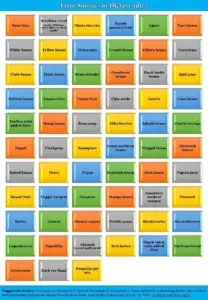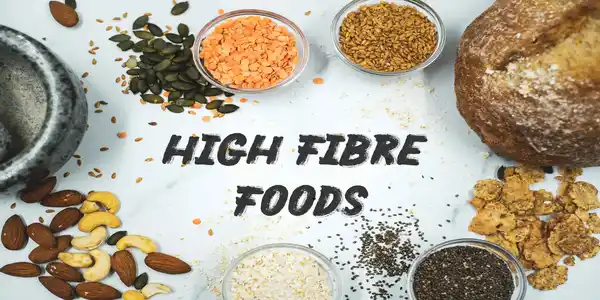High Fiber Foods: In the pursuit of a balanced and healthy lifestyle, incorporating high fiber foods into your diet is a smart choice. Fiber is not only essential for maintaining proper digestion but also plays a crucial role in weight management, making you feel fuller for longer. From high fiber breakfast options to foods suitable for toddlers and kids, as well as our furry friends, we’ve compiled a comprehensive list of 45 high-fiber foods that are not only delicious but also incredibly beneficial for your overall well-being.
Certainly, here’s the table showing the recommended fiber intake for people of different ages for both males and females:
| Age Group | Male | Female |
|---|---|---|
| 1-3 years | 14 grams | 14 grams |
| 4-8 years | 19.6 grams | 16.8 grams |
| 9-13 years | 25.2 grams | 22.4 grams |
| 14-18 years | 30.8 grams | 25.2 grams |
| 19-30 years | 38 grams | 25.2 grams |
| 31-50 years | 38 grams | 25 grams |
| 51+ years | 30 grams | 21 grams |
- Oats: Starting your day with a bowl of oatmeal is an excellent way to kickstart your fiber intake. Oats are a high-fiber breakfast staple that can also help regulate blood sugar levels.
- Apples: “An apple a day keeps the doctor away” rings true when it comes to fiber intake. Apples are a convenient and portable snack that’s high in fiber and nutrients.
- Berries: Berries like strawberries, raspberries, and blueberries are bursting with fiber and antioxidants, making them a perfect addition to your breakfast or as a snack.
- Avocado: Creamy and nutrient-dense, avocados are a great source of healthy fats and fiber. They can be spread on toast, added to salads, or enjoyed on their own.
- Legumes: Beans, lentils, and chickpeas are not only rich in fiber but also provide plant-based protein. They can be used in various dishes, from soups to salads.
- Whole Grains: Opt for whole grains like brown rice, quinoa, and whole wheat pasta over refined grains. These options are high in fiber and provide sustained energy.
- Sweet Potatoes: This colorful vegetable is not only rich in fiber but also packed with vitamins and minerals. Enjoy baked or roasted sweet potatoes for a satisfying meal.
- Broccoli: Broccoli is a cruciferous vegetable that offers a good amount of fiber along with essential nutrients. Steam, roast, or add it to stir-fries.
- Carrots: Crunchy and satisfying, carrots are a convenient high-fiber snack. They are also a great addition to salads and vegetable platters.
- Spinach: Leafy greens like spinach are not only rich in fiber but also low in calories. Use spinach as a base for salads or blend it into smoothies.
- Chia Seeds: These tiny seeds pack a punch when it comes to fiber content. They can absorb liquid and create a gel-like consistency, making them perfect for puddings and smoothies.
- Flaxseeds: Flaxseeds are another excellent source of fiber and healthy fats. Ground flaxseeds can be added to yogurt, oatmeal, or baked goods.
- Nuts: Almonds, walnuts, and pistachios are high-fiber nuts that also provide beneficial fats. Enjoy a handful as a snack or add them to your meals.
- Bran Cereals: Bran cereals are specifically designed to be high in fiber. Look for options with minimal added sugars for a nutritious breakfast.
- Pears: Similar to apples, pears are a sweet and juicy fruit that contributes to your daily fiber intake. Enjoy them as a snack or slice them into salads.
- Whole Wheat Bread: When opting for bread, choose whole wheat varieties over refined white bread. Whole wheat bread is higher in fiber and nutrients.
- Prunes: Prunes, or dried plums, are well-known for their digestive benefits. They’re a natural remedy for constipation due to their high fiber content.
- Cauliflower: Cauliflower is a versatile vegetable that can be used to create rice, pizza crust, and even mashed “potatoes.” It’s a low-calorie, high-fiber option.
- Popcorn: Air-popped popcorn is a whole-grain snack that’s surprisingly high in fiber. Skip the excessive butter and salt for a healthier option.
- Brussels Sprouts: These mini-cabbages are not only delicious when roasted but also provide a good dose of fiber and vitamins.
- Kiwi: Kiwi is a tropical fruit that’s rich in fiber and vitamin C. Its unique flavor and texture make it a delightful addition to your fruit selection.
- Raspberries: Raspberries are not only tasty but also one of the highest fiber fruits available. Sprinkle them on yogurt or enjoy them as a refreshing snack.
- Quinoa: This ancient grain is not only a complete protein source but also boasts a high fiber content. Incorporate quinoa into salads, and bowls, or use it as a side dish.
- Black Beans: Black beans are a versatile legume that can be added to soups, and salads, and even used to make delicious bean burgers. They’re rich in both fiber and protein.
- Rye Bread: Another wholesome bread option, rye bread, provides a good amount of fiber. Its distinct flavor makes it a delightful choice for sandwiches and toasts.
- Artichokes: Artichokes are a unique vegetable that offers both dietary fiber and antioxidants. Enjoy them steamed with a light dipping sauce.
- Oranges: Oranges are not only a fantastic source of vitamin C but also contain soluble fiber. Opt for whole oranges or fresh orange juice to benefit from their fiber content.
- Edamame: Edamame, or young soybeans, are a tasty snack that’s high in fiber and protein. Enjoy them boiled and lightly salted for a satisfying munch.
- Barley: Barley is a whole grain that’s rich in soluble fiber, making it an excellent addition to soups and stews. It provides a hearty and nutritious base.
- Pumpkin Seeds: Pumpkin seeds, also known as pepitas, offer a crunchy texture and a healthy dose of fiber. They’re great for snacking or adding to salads.
- Whole Grain Pasta: Upgrade your pasta dishes by opting for whole-grain pasta. It provides more fiber compared to traditional pasta, ensuring a more nutritious meal.
- Lentil Soup: Lentil soup is not only warm and comforting but also a wonderful source of fiber. Enjoy a bowl of hearty lentil soup for a satisfying and nutritious meal.
- Bran Muffins: Bran muffins are a classic way to boost your fiber intake. Opt for homemade versions with whole grains and minimal added sugars.
- Almond Butter: Swap out regular peanut butter for almond butter to add more fiber to your diet. Spread it on whole wheat toast or use it as a dip for fruits.
- Brown Rice Cakes: Brown rice cakes make for a simple and crunchy snack that’s high in fiber. Top them with avocado or nut butter for added flavor.
- Split Peas: Split peas are another legume packed with fiber and protein. They’re a key ingredient in hearty soups like split pea soup.
- Bran Flakes: Bran flakes are a cereal option specifically designed to be high in fiber. Pair them with your choice of milk and fresh fruits for a nutritious breakfast.
- Cabbage: Cabbage is a low-calorie vegetable that can be used in a variety of dishes. From coleslaw to stir-fries, cabbage contributes to your daily fiber intake.
- Beets: Beets are not only vibrant and flavorful but also high in fiber. Roast or steam them for a nutritious side dish or salad topping.
- Whole Wheat Tortillas: Opt for whole wheat tortillas when making wraps or quesadillas. They provide more fiber than their white flour counterparts.
- Bran Cereal Bars: On-the-go? Choose bran cereal bars that provide a quick and convenient source of fiber and energy.
- Brown Rice: Brown rice is a staple whole grain that’s rich in fiber and nutrients. It serves as a versatile base for various dishes.
- Green Peas: Green peas are a sweet and nutritious vegetable that can be added to pasta dishes, salads, and stir-fries to increase your fiber intake.
- Bran Pancakes: Upgrade your breakfast with bran pancakes made using whole grains. Top them with fruits and a drizzle of honey for a delightful meal.
- Guava: Guava is a tropical fruit that offers a significant amount of dietary fiber. Enjoy it fresh or blend it into smoothies for a burst of flavor.

Incorporating these high-fiber foods into your diet can have a positive impact on your digestive health, weight management, and overall well-being. Whether you’re looking for high-fiber options for breakfast, snacks, or meals suitable for toddlers and kids, these choices are versatile and delicious. Remember to gradually increase your fiber intake to prevent digestive discomfort, and drink plenty of water to help the fiber work its magic.
Adding these high-fiber foods to your diet can diversify your nutrient intake and promote optimal digestion. Whether you’re looking for savory or sweet options, there’s a wide array of choices to suit your taste preferences and dietary needs. Remember that combining different high-fiber foods throughout your meals can contribute to a balanced and health-supporting diet.
High-Fiber Foods for Specific Needs:
- High-Fiber Foods Chart for Constipation: For those struggling with constipation, focus on incorporating foods like prunes, bran cereals, beans, and flaxseeds into your diet. These options can promote regular bowel movements and alleviate discomfort.
- High-Fiber Foods to Stop Diarrhea: If you’re dealing with diarrhea, opt for soluble fiber sources like bananas, white rice, and applesauce. These foods can help absorb excess water and promote firmer stools.
- High Fiber Foods for Toddlers and Kids: When introducing high fiber foods to toddlers and kids, consider options like apples, carrots, whole grain crackers, and yogurt. These choices are kid-friendly and support healthy digestion.
- High Fiber Foods for Dogs: Even our furry friends can benefit from high fiber foods. Pumpkin, sweet potatoes, and green beans are safe options to add to your dog’s diet, aiding in digestion and gut health.
Printable List of High Fiber Foods: For your convenience, you can find a printable list of these high-fiber foods on our website. Whether you’re grocery shopping or planning meals, having a handy reference can make it easier to incorporate these nutritious options into your routine.
In conclusion, a diet rich in high-fiber foods offers a multitude of benefits, ranging from improved digestion to enhanced weight management. By selecting a variety of fiber-packed options, you can create well-rounded and satisfying meals that contribute to your overall health. Remember to consider your individual needs, whether you’re aiming to combat constipation, find relief from diarrhea, cater to young ones, or even provide for your four-legged companions. With this comprehensive list and the right choices, you can embark on a journey to better digestive health and well-being.
High Fiber Foods Additional Tips:
High Fiber Foods Faqs:
Foods that are high in fiber include a wide variety of options, ranging from fruits and vegetables to whole grains and legumes. Some popular high fiber foods include oats, apples, berries, avocados, beans, lentils, whole wheat pasta, and broccoli.
High fiber foods are those that contain a significant amount of dietary fiber, a type of carbohydrate that cannot be digested by the body. They contribute to healthy digestion, weight management, and can help prevent certain chronic diseases.
There are numerous foods that have high fiber content. These include fruits like pears, raspberries, and apples; vegetables such as carrots, spinach, and Brussels sprouts; legumes like chickpeas and black beans; and whole grains like quinoa and brown rice.
Some examples of high fiber foods are chia seeds, sweet potatoes, whole wheat bread, almonds, flaxseeds, and kale. Including a mix of these foods in your meals can help you achieve your daily fiber goals.
High fiber foods play a crucial role in promoting digestive health. They add bulk to stool, aiding in regular bowel movements and preventing constipation. Additionally, high fiber foods can help control blood sugar levels, lower cholesterol, and support weight management.
Increasing your fiber intake is easy with a few simple changes. Start by choosing whole grains over refined grains, snacking on fresh fruits and vegetables, and including legumes in your meals. Gradually increase your fiber intake to prevent digestive discomfort.
Yes, high fiber foods can be beneficial for weight loss. They promote satiety, making you feel full for longer periods, which can lead to reduced overall calorie intake. Additionally, fiber-rich foods tend to be lower in calories, contributing to a balanced diet.
Absolutely! High fiber foods for kids can include fruits like apples and pears, vegetables such as carrots and bell peppers, and whole grain options like whole wheat bread and brown rice. These choices support healthy digestion and provide essential nutrients for growing children.
Kickstart your day with high fiber breakfast options like oatmeal topped with berries, whole grain cereal with almond milk, or whole wheat toast spread with almond butter. These choices provide sustained energy and keep you feeling full until your next meal.
Yes, you can find printable lists of high fiber foods online. These lists can serve as handy references while grocery shopping or meal planning, ensuring you select a diverse range of fiber-rich options. What Foods Are High in Fiber?
What Are High Fiber Foods?
What Foods Have High Fiber?
What Are Some High Fiber Foods?
What Is High Fiber Foods' Role in a Healthy Diet?
How Can I Increase My Fiber Intake?
Can High Fiber Foods Help with Weight Loss?
Are There High Fiber Foods for Kids?
What Are Some High Fiber Breakfast Foods?
Can I Find a Printable List of High Fiber Foods?
Please visit us to learn more about Health and Information.
Sources:
- Mayo Clinic. “Nutrition and Healthy Eating.” Fiber: How to Increase the Amount in Your Diet. https://www.mayoclinic.org/healthy-lifestyle/nutrition-and-healthy-eating/in-depth/fiber/art-20043983
- WebMD. “Fiber-Rich Foods.” [https://www.webmd.com/diet/ss/slideshow-high-fiber-foods](https://www.webmd.com/diet/ss/slideshow-high






[…] Moong dal (mung bean) cheela is a protein-rich crepe-like dish. Blend soaked moong dal with spices and water to create a batter. Cook the batter on a skillet to make thin, savory pancakes that are high-fiber food. […]